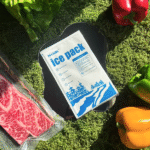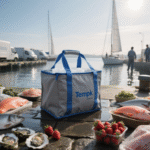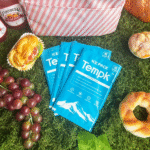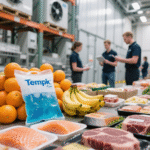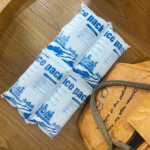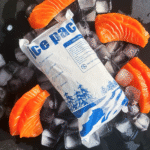Trockeneis-Packfolie für den Impfstofftransport: Ein vollständiger Leitfaden für den sicheren und effizienten Impfstoffversand
Die Gewährleistung des sicheren Transports von Impfstoffen ist für die Aufrechterhaltung ihrer Wirksamkeit von entscheidender Bedeutung. Trockeneis-Packfolien spielen eine entscheidende Rolle dabei, Impfstoffe während des Transports auf der erforderlichen Temperatur zu halten. In diesem Leitfaden wird die Bedeutung von Trockeneis-Packplatten untersucht, wie sie funktionieren, und die besten Praktiken, um sicherzustellen, dass Impfstoffe in optimalem Zustand geliefert werden.

Was sind Trockeneisbeutel für den Impfstofftransport??
Trockeneis-Packplatten für den Impfstofftransport sind speziell entwickelte Platten aus Trockeneis, Das ist verfestigtes Kohlendioxid. Diese Platten werden im Kühlkettenprozess verwendet, eine entscheidende Logistikmethode, um temperaturempfindliche Güter wie Impfstoffe während des Transports auf der erforderlichen Temperatur zu halten. Die Fähigkeit von Trockeneis, extrem niedrige Temperaturen aufrechtzuerhalten, ohne in einen flüssigen Zustand überzugehen, macht es zu einer idealen Lösung, um Impfstoffe bei langen Transporten kühl zu halten.
Eigenschaften von Trockeneis:
-
Sublimation: Trockeneis sublimiert bei -78,5 °C direkt vom Feststoff in den gasförmigen Zustand, Aufrechterhaltung einer konstanten Temperatur ohne die Verschmutzung durch flüssiges Wasser.
-
Regelung extrem niedriger Temperaturen: Es ist besonders effektiv für den Transport von Impfstoffen, die Temperaturen erfordern, die viel niedriger sind als bei herkömmlicher Kühlung.
Wie geht's Trockeneis-Packplatten für den Impfstofftransport Arbeiten?
Trockeneis-Packfolien funktionieren, indem sie langsam und mit gleichmäßiger Geschwindigkeit sublimieren, die Temperatur der Umgebung während der gesamten Fahrtdauer auf dem erforderlichen Niveau zu halten. Typischerweise, Trockeneis-Packplatten werden in isolierte Behälter gelegt. Diese Behälter, zusammen mit den Trockeneisplatten, bilden eine hochwirksame Lösung für den Impfstofftransport, insbesondere beim Transport von Impfstoffen, die ultragekühlt gelagert werden müssen.
Der Sublimationsprozess ist ein Schlüsselfaktor, der zur Aufrechterhaltung der Temperatur beiträgt, So bleiben die Impfstoffe bei optimalen Temperaturen zwischen -20 °C und -70 °C, abhängig vom Impfstofftyp. Dies ist besonders wichtig für Impfstoffe wie mRNA-Impfstoffe, die Temperaturen unter Null erfordern.
Warum sind Trockeneisbeutel für den Impfstofftransport für den Impfstoffversand so wichtig??
Temperaturschwankungen können Impfstoffe unwirksam machen, Aus diesem Grund sind Trockeneisbeutel für den Transport von Impfstoffen so wichtig. Diese Blätter stellen sicher, dass Impfstoffe innerhalb des erforderlichen Temperaturbereichs versendet werden, um eine Beeinträchtigung während der Fahrt zu verhindern.
Schlüsselvorteile:
-
Temperaturstabilität: Sie bleiben stabil, extrem niedrige Temperaturen während des gesamten Versandprozesses, Verhindert, dass Impfstoffe durch Hitzeeinwirkung ihre Wirksamkeit verlieren.
-
Vorschriftenregulierung: Trockeneis stellt sicher, dass Sendungen den internationalen Standards für den sicheren Transport von Impfstoffen entsprechen, Vermeidung von Bußgeldern oder Problemen bei der Zollkontrolle.
-
Kosteneffizienz: Indem wir den Verderb von Impfstoffen verhindern, Trockeneis reduziert Abfall, Dadurch werden erhebliche Kosten eingespart, die mit der Entsorgung unbrauchbarer Impfstoffe verbunden sind.
Arten von Impfstoffen, für deren Transport Trockeneis erforderlich ist
Einige Impfstoffe benötigen für Lagerung und Transport ultrakalte Temperaturen. Hier ist eine Aufschlüsselung der Impfstofftypen, die für einen effektiven Versand Trockeneis benötigen:
| Impfstofftyp | Temperaturanforderung | Rolle von Trockeneis |
|---|---|---|
| mRNA-Impfstoffe | -70° C oder niedriger | Unverzichtbar für die Aufrechterhaltung der erforderlichen Temperaturen |
| Grippeimpfstoffe | 2° C bis 8 ° C. | Hilft, die Kühlkette während des Transports aufrechtzuerhalten |
| Andere temperaturempfindliche Impfstoffe | Variiert von -20°C bis 8°C | Bietet Kühlung für längere Transporte |
Notiz: mRNA-Impfstoffe wie Pfizer und Moderna erfordern extrem niedrige Temperaturen, Daher ist Trockeneis für die Gewährleistung ihrer Wirksamkeit während des Transports unerlässlich.
So verwenden Sie Trockeneis-Packblätter für den Impfstofftransport?
Die effektive Verwendung von Trockeneis-Packfolien erfordert mehrere wichtige Schritte, um sicherzustellen, dass die Impfstoffe die erforderliche Temperatur behalten:
-
Bereiten Sie die Trockeneis-Packblätter vor: Frieren Sie die Trockeneisplatten vorher ein, um sicherzustellen, dass sie die richtige Temperatur haben.
-
Packen Sie die Impfstoffe und das Trockeneis ein: Legen Sie die Trockeneisplatten in einen isolierten Versandbehälter und ordnen Sie die Impfstoffe im Innenfach an, um einen direkten Kontakt mit dem Trockeneis zu verhindern.
-
Den Behälter versiegeln: Verschließen Sie den Behälter ordnungsgemäß, um das Eindringen von Wärme zu verhindern und die Temperaturstabilität zu gewährleisten.
-
Überwachen Sie die Temperatur: Verwenden Sie Temperaturlogger, um sicherzustellen, dass der Container während des gesamten Transports die richtige Temperatur behält.
Sicherheitstipp: Immer Trockeneis mit Sorgfalt bewältigen. Verwenden Sie Handschuhe, Brille, und arbeiten Sie in gut belüfteten Bereichen, um das Risiko von Erfrierungen oder Kohlendioxidansammlungen zu vermeiden.
Best Practices für die Verwendung von Trockeneis-Packfolien beim Impfstofftransport
Um die bestmöglichen Ergebnisse bei der Verwendung von Trockeneis-Packfolien für den Impfstoffversand zu gewährleisten, Folgen Sie diesen Best Practices:
-
Verwenden Sie die richtige Verpackung: Stellen Sie sicher, dass der Versandbehälter ausreichend isoliert ist, um die Trockeneisplatten zu ergänzen und externe Temperaturschwankungen zu verhindern.
-
Halten Sie lokale und internationale Vorschriften ein: Überprüfen Sie stets, ob Ihre Versandmethoden sowohl den lokalen als auch den globalen Standards für den Impfstofftransport entsprechen.
-
Überwachen Sie die Temperatur während des Transports: Implementieren Sie Temperaturprotokollierungssysteme, um zu verfolgen und zu überprüfen, ob die erforderlichen Bedingungen während der Fahrt eingehalten werden.
Auswahl der richtigen Trockeneis-Packfolie für den Impfstoffversand
Die Wahl der richtigen Trockeneis-Packfolie hängt von mehreren Faktoren ab, einschließlich der Dauer der Sendung, die spezifischen Temperaturanforderungen für den Impfstoff, und die Isoliereigenschaften des Versandbehälters. Für längere Sendungen, Möglicherweise ist mehr Trockeneis erforderlich, und der Versandbehälter sollte eine ausreichende Isolierung bieten.
Beispiel: Wenn Sie Impfstoffe versenden, die eine Temperatur von -70 °C erfordern, Stellen Sie sicher, dass die Trockeneis-Packplatten diese Temperatur während der gesamten Transportdauer aufrechterhalten können.
Häufig gestellte Fragen (FAQ)
Wie lange ist Trockeneis beim Impfstofftransport haltbar??
Die Haltbarkeit von Trockeneis hängt von der verwendeten Menge und der Qualität der Isolierung ab. Typischerweise, Trockeneis hält dazwischen 18 Zu 24 Stunden in gut isolierten Behältern.
Kann Trockeneis für alle Arten von Impfstoffen verwendet werden??
NEIN, Trockeneis ist ideal für Impfstoffe, die Temperaturen unter Null erfordern. Für Impfstoffe, die Temperaturen zwischen 2 °C und 8 °C benötigen, Standardkühlung ist besser geeignet.
2025 Trends im Impfstoffversand und in der Kühlkettenlogistik
Die Nachfrage nach Impfstofftransportlösungen, insbesondere Trockeneis-Packplatten, ist aufgrund der zunehmenden Produktion und Verteilung von Impfstoffen sprunghaft angestiegen. Technologische Innovationen machen die Kühlkette zuverlässiger und effizienter, Ermöglicht den weltweiten Transport von Impfstoffen unter strenger Temperaturkontrolle.
Aufkommende Trends:
-
Automatisierung: Die Integration von KI- und IoT-Technologie revolutioniert die Kühlkettenlogistik, Bereitstellung einer Echtzeitüberwachung und Reduzierung der Notwendigkeit manueller Eingriffe.
-
Nachhaltigkeit: Es werden umweltfreundliche Materialien entwickelt, um herkömmliche Isolierungen zu ersetzen, Reduzierung der Umweltauswirkungen des Impfstofftransports.
Schlüsseleinsicht: Technologiebedingte Verbesserungen in der Kühlkettenlogistik machen den Impfstofftransport effizienter und stellen gleichzeitig sicher, dass die Impfstoffe in optimalem Zustand ankommen.
Abschluss: Gewährleistung eines sicheren Impfstofftransports
Trockeneis-Packfolien sind für den sicheren Transport temperaturempfindlicher Impfstoffe unerlässlich. Durch das Verständnis der Bedeutung von Trockeneis für die Aufrechterhaltung der erforderlichen Temperatur und die Einhaltung bewährter Verfahren, Sie können dazu beitragen, dass Impfstoffe wirksam und einsatzbereit an ihrem Bestimmungsort ankommen. Da die Verbreitung von Impfstoffen weltweit zunimmt, Diese Lösungen werden ständig weiterentwickelt, bietet neue Möglichkeiten zur Gewährleistung der Sicherheit, Effizienter Impfstoffversand.
Aufruf zum Handeln:
Ausführlichere Anleitungen zur Optimierung Ihrer Impfstofftransportlogistik mit Trockeneis, Kontaktieren Sie uns noch heute für individuelle Empfehlungen.
















